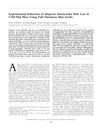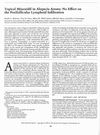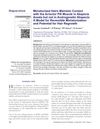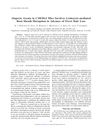TLDR Hair loss in mice starts with immune cells damaging hair roots before it becomes visible.
In this study, alopecia areata (AA) was induced in C3H/HeJ mice by grafting AA-affected skin, with a delay of 8-12 weeks before visible hair loss. Inflammation initially appeared around anagen-stage hair follicles near the graft site and later spread to distant sites, focusing on these follicles by 10-12 weeks. The inflammation was primarily composed of CD4+ and CD8+ cells, with CD8+ cells penetrating the follicles by 12 weeks. Electron microscopy revealed significant lymphocyte and macrophage infiltration in the root sheaths, leading to hair follicle dystrophy. The findings indicated that follicular inflammation and root sheath disruption occurred well before overt hair loss, with the severity of inflammation reaching a threshold before hair loss became visible.
114 citations
,
August 2002 in “Journal of Investigative Dermatology” Alopecia areata is caused by an immune response, and targeting immune cells might help treat it.
77 citations
,
June 2002 in “Journal of Investigative Dermatology” CD44 variant changes start alopecia areata, but don't maintain it.
 131 citations
,
November 1998 in “The journal of investigative dermatology/Journal of investigative dermatology”
131 citations
,
November 1998 in “The journal of investigative dermatology/Journal of investigative dermatology” Skin grafts on mice can cause an immune response leading to hair loss, useful for studying human hair loss conditions.
91 citations
,
March 1996 in “Archives of Dermatological Research” Certain cytokines and growth factors can inhibit hair growth and may affect alopecia areata.
178 citations
,
June 1994 in “Journal of Investigative Dermatology” Alopecia areata in these mice is inherited, more common in young females, and can be treated with triamcinolone acetonide.
 33 citations
,
July 1992 in “Journal of Investigative Dermatology”
33 citations
,
July 1992 in “Journal of Investigative Dermatology” Minoxidil doesn't affect perifollicular lymphoid infiltration in alopecia areata patients.
78 citations
,
July 1984 in “Journal of Investigative Dermatology”
 22 citations
,
July 2012 in “International Journal of Trichology”
22 citations
,
July 2012 in “International Journal of Trichology” Miniaturized hairs stay connected to muscle in alopecia areata, allowing possible regrowth, but not in androgenetic alopecia.
6 citations
,
March 2011 in “European Journal of Dermatology” Nestin-positive cells are important for hair follicle regeneration in alopecia areata.
 January 2008 in “Journal of Clinical Dermatology”
January 2008 in “Journal of Clinical Dermatology” Integrin alpha-6 and p63 proteins may play a role in hair loss and are important for hair growth and maintenance.
Alopecia areata is an autoimmune disease that targets hair follicles.
 37 citations
,
November 2003 in “Veterinary pathology”
37 citations
,
November 2003 in “Veterinary pathology” Hair loss in mice starts with immune cells damaging hair roots before it becomes visible.





